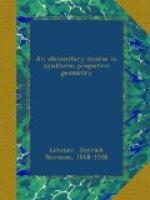CHAPTER II — RELATIONS BETWEEN FUNDAMENTAL FORMS IN ONE-TO-ONE CORRESPONDENCE WITH EACH OTHER
23. Seven fundamental forms. In the preceding chapter we have called attention to seven fundamental forms: the point-row, the pencil of rays, the axial pencil, the plane system, the point system, the space system, and the system of lines in space. These fundamental forms are the material which we intend to use in building up a general theory which will be found to include ordinary geometry as a special case. We shall be concerned, not with measurement of angles and areas or line segments as in the study of Euclid, but in combining and comparing these fundamental forms and in “generating” new forms by means of them. In problems of construction we shall make no use of measurement, either of angles or of segments, and except in certain special applications of the general theory we shall not find it necessary to require more of ourselves than the ability to draw the line joining two points, or to find the point of intersections of two lines, or the line of intersection of two planes, or, in general, the common elements of two fundamental forms.
24. Projective properties. Our chief interest in this chapter will be the discovery of relations between the elements of one form which hold between the corresponding elements of any other form in one-to-one correspondence with it. We have already called attention to the danger of assuming that whatever relations hold between the elements of one assemblage must also hold between the corresponding elements of any assemblage in one-to-one correspondence with it. This false assumption is the basis of the so-called “proof by analogy” so much in vogue among speculative theorists. When it appears that certain relations existing between the points of a given point-row do not necessitate the same relations between the corresponding elements of another in one-to-one correspondence with it, we should view with suspicion any application of the “proof by analogy” in realms of thought where accurate judgments are not so easily made. For example, if in a given point-row u three points, A, B, and C, are taken such that B is the middle point of the segment AC, it does not follow that the three points A’, B’, C’ in a point-row perspective to u will be so related. Relations between the elements of any form which do go over unaltered to the corresponding elements of a form projectively related to it are called projective relations. Relations involving measurement of lines or of angles are not projective.
25. Desargues’s theorem. We consider first the following beautiful theorem, due to Desargues and called by his name.
If two triangles, _A__, __B__, __C__ and __A’__, __B’__, __C’__, are so situated that the lines __AA’__, __BB’__, and __CC’__ all meet in a point, then the pairs of sides __AB__ and __A’B’__, __BC__ and __B’C’__, __CA__ and __C’A’__ all meet on a straight line, and conversely._




